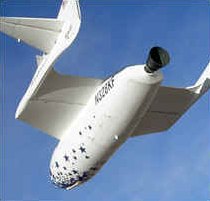Here is yet another one.. Pretty cool man...
http://news.bbc.co.uk/1/hi/sci/tech/1032148.stm

How it works
The Islay wave power generator was designed and built by Wavegen and researchers from Queen's University in Belfast and has financial backing from the European Union.
Known as Limpet 500 (Land Installed Marine Powered Energy Transformer), it will feed 500 kilowatts of electricity into the island's grid.
Limpet was born out of a 10-year research project on the island where the team had built a demonstration plant capable of generating 75 Kilowatts of electricity.
The power generator consists of two basic elements:
A wave energy collector.
A generator to turn this into electricity.
The energy collector comprises a sloping reinforced shell built into the rock face on the shoreline with an inlet big enough to allow seawater to freely enter and leave a central chamber.
As waves enter the shell chamber, the level of water rises, compressing the air in the top of the chamber.
This air is then forced through a "blowhole" and into the "Wells Turbine", designed by Professor Alan Wells of Queen's University.
The turbine has been designed to continue turning the same way irrespective of the direction of the airflow.
As the water inside the chamber recedes as the waves outside draw back, the air is sucked back under pressure into the chamber, keeping the turbine moving.
This constant stream of air in both directions, created by the oscillating water column, produces enough movement in the turbine to drive a generator which converts the energy into electricity.
http://news.bbc.co.uk/1/hi/sci/tech/1032148.stm

How it works
The Islay wave power generator was designed and built by Wavegen and researchers from Queen's University in Belfast and has financial backing from the European Union.
Known as Limpet 500 (Land Installed Marine Powered Energy Transformer), it will feed 500 kilowatts of electricity into the island's grid.
Limpet was born out of a 10-year research project on the island where the team had built a demonstration plant capable of generating 75 Kilowatts of electricity.
The power generator consists of two basic elements:
A wave energy collector.
A generator to turn this into electricity.
The energy collector comprises a sloping reinforced shell built into the rock face on the shoreline with an inlet big enough to allow seawater to freely enter and leave a central chamber.
As waves enter the shell chamber, the level of water rises, compressing the air in the top of the chamber.
This air is then forced through a "blowhole" and into the "Wells Turbine", designed by Professor Alan Wells of Queen's University.
The turbine has been designed to continue turning the same way irrespective of the direction of the airflow.
As the water inside the chamber recedes as the waves outside draw back, the air is sucked back under pressure into the chamber, keeping the turbine moving.
This constant stream of air in both directions, created by the oscillating water column, produces enough movement in the turbine to drive a generator which converts the energy into electricity.




